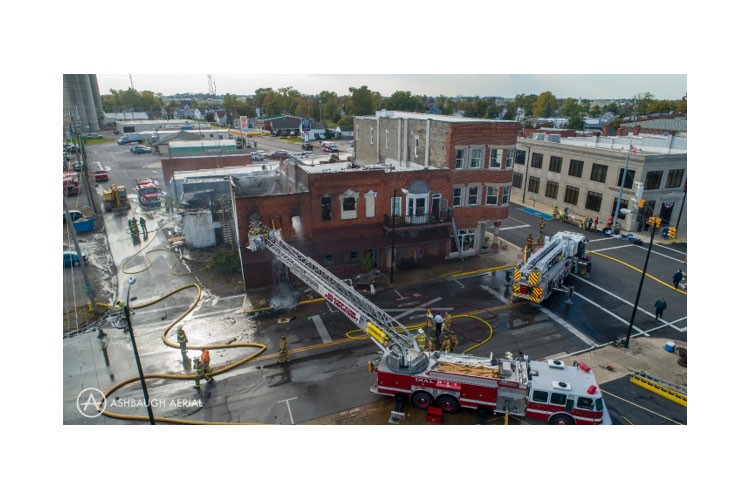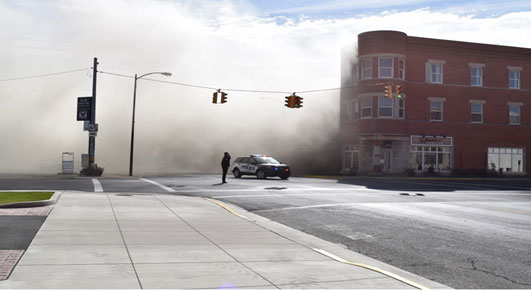
By Joe Pronesti
All photos and video courtesy of Ashbaugh Aerial and Chief Goodwin
October 22, 2018 started out like any other day in the small village of Leipsic (“pronounced lipsik”), Ohio. Located in Putnam County, Leipsic is home to 2,000 residents and is protected by a fire department of around 20 paid-on-call members. But at 1200 hours, this small department was faced with a major fire in its downtown that threatened one of the village’s most popular establishment.
The Buildings and Occupancies
The location of the fire was in the B-C corner of building #1 (picture below) in a one-story “step down,” measuring approximately 900 square feet. The block had four separate buildings that ranged from one story to three stories and was built in 1905 of ordinary construction. (Type III) The first two buildings, buildings #1 and #2, were used as storage. Both buildings had very limited means of ingress and egress. All windows were boarded up with plywood and had vinyl siding covering them. This is identified as a hazard because it substantially delayed an offensive attack on the building and undoubtedly indicated a delayed discovery fire.
The third building was divided into residential occupancies, and the fourth building was a three-story deli/café and loft apartments. There was a fire wall in the cockloft of these buildings as well.
RELATED TRAINING: Trenching Strategy: Drawing a Line in the Sand | Main Street Fires: Is Your Department Ready? | Main Street Roof Operations | Truck Company Ops: Louver Cut
The fire was traveling through the cockloft/attic area of building #1 and breached the firewall of building #2. Firefighters used two elevated master streams to attack the cockloft areas through the front windows of the #1 and #2 building. Crews did not have much success with the master streams and needed to stop the fire before reaching the cockloft of the third building, so command decided to perform trench ventilation on the #2 building at the firewall leading to the #3 building. Multiple firefighters were organized to perform the trench cut and in support of the operation. Two drones with thermal imaging capabilities were placed to ensure the fire was not growing behind the firefighters or underneath them.

Civilian Life Hazards
Firefighters could not initially determine any civilian life hazard in the residential occupancies next door to fire building. Crews performed searches on these portions of the structure. The property owner arrived on scene and confirmed that the storage area was vacant, and his family was all accounted for along with anyone having any close involvement with the buildings. An all-clear of all structures in the fire block was confirmed 40 minutes into the incident.
Water
Initially, firefighters used two hydrants to supply two engines and one aerial device. As the scene progressed and more aerial devices were brought in, two more hydrants were picked up. Roughly an hour into the incident, the village water department superintendent notified command that crews were going to need to start looking into alternative water supplies because of the village’s systems inability to sustain the demand. Master streams and handlines in the original fire building were shut down and primary suppression focus and water application was directed to the cocklofts and firewalls on the leading edge of the fire.
Initial Size Up and Fire Attack
At 1201 hours, smoke was reported coming from the roof of 200 East Main Street. Upon arrival, fire and heavy smoke was coming from the rear of the easternmost building of a set of four attached ordinary constructed buildings. The temperature at the time of the call was 61°F with clear skies and a sustained wind speed of 15 mph. The wind direction was out of the west, which allowed smoke to obscure much of the A side of the structures.
Initially, an offensive attack was mounted near the B-C corner, but within several minutes the fire had grown substantially throughout building #1 and was pushing smoke out of several places in the building. It was then determined that this would be a defensive fire because of the rapid progression of the fire and the possibility of a delayed discovery of the fire. The fire was traveling through the cockloft/attic area of building #1 and breached the firewall of building #2. Two elevated master streams were used to attack the cockloft areas through the front windows of the #1 and #2 building.
Trench Cut Attempt and Collapse
Without much success from the master streams and needing to stop the fire before it advanced to the cockloft of the third building, it was determined to perform trench ventilation on the #2 building at the firewall leading to the #3 building. Crews went up onto the roof to perform such a cut. Two firefighters initiated the cut, stating that the roof of building #3 was very solid and there were no concerns with working off it. Firefighters began the cut and were replaced when their air began running low. The two replacement firefighters continued the cut. Because of roof line elevation differences, the second pair of firefighters needed to climb on top of the firewall to complete the cut. When the two original firefighters were replaced, there was no information passed on to the replacement firefighters. The original firefighters recognized that the roof was becoming unstable towards the rear and did not report that issue.
One firefighter remained on the #3 roof holding onto his colleague’s self-contained breathing apparatus; this member was on the fire wall. It was shortly after the cut was reinitiated that visibility diminished and the roof along with the firewall from building #2 collapsed from the rear of the structure. The firefighter that remained on the #3 building roof said that he heard the collapse before he saw it. He was able to pull his colleague off the wall just prior to collapse. Both firefighters retreated off the roof without injury.
The Use of Drones
Throughout the fire service there has been an increase use of drones to help aid the incident commander in making decisions. During this fire, a drone using infrared imaging was launched and the close call collapse was caught on tape. Drones have a place and their use and procedures need to be established prior to the fire. The drones used at this event were controlled by experienced operators whom the incident commander knew and had a rapport with.
It should be noted that the time and procedures to use drones on a “Main Street” fire–or any other fire, for that matter–need to be established prior to the incident. In my opinion, an incident commander has myriad other problems to worry about on the fireground without having a citizen coming up to volunteer the use of a drone. This may only compound the headaches.
RELATED: First-Due Battalion Chief: Going Above the Fire | Getting Ahead of the Top-Floor Fire | VENTILATING FLAT ROOFS
Lessons Learned
Water Supply: Water supply at “Main Street” fire events can put a strain on a small town’s supply system. If you provide protection in a hydrant area you may want to come up with specific plans when dealing with a fire in a connected block of structures. Setting up all your pumpers in one line will rob you of valuable water. Resist the temptation of placing a pumper on a hydrant directly in front of the original fire building. These fires can move fast, and when you shift efforts to protect what is not burned and give up on what is burned, you may leave your pumping engine in a collapse zone.
Consider carrying water main maps or have some sort of idea on the flows of hydrants in your “Main Street” areas. Mutual aid companies may need to be told to bypass certain hydrants connected to the same main and pick up a water supply on a separate route.
Even if you have the luxury of hydrants, the ability to get water from a tanker shuttle type of set up can pay dividends. In my city, which is fully protected by hydrants every 300 feet, we were faced with a fire in a three-city-block mill building, with five blocks of residential structures surrounding the mill being endangered. We used my county’s tanker shuttle procedures and ended up pumping over a million gallons of water from tankers. The bottom line is have a water plan when sizing up your “Main Street fire.”
Trench Cut: A trench cut, sometimes referred also as “strip ventilation,” is a long, narrow roof cut that is meant to act as a fire break. Some Type III ordinary constructed buildings may lend themselves to the use of trench cuts. The key is that a ventilation hole or holes must be made prior to the trench cut. Failure in doing this may allow the fire to skip right past the trench cut, rendering its purpose useless.
Staffing up on the roof needs to be augmented. There should also be a chief level command officer sent up to supervise the cut and to monitor the safety of the operating members. Small departments are generally not used to performing these types of procedures on a regular basis. That doesn’t mean that a small department can’t perform a trench cut, but its firefighters must be trained on the technique and supervised correctly when the time comes to use it. When successful, you may save a building. This is an unusual tactic and must be practiced repeatedly, especially if you protect “Main Street” buildings.
Impact of streams on the building: The fire service is used to fighting the 2 ½-story residential fire. The tactics we use at these events are usually quick, and most of the time we have things handled in an expedient manner. This included the use of water. We may employ smaller streams at the residential house fire but must take into account the power and energy of large-caliber streams on a commercial building. When reviewing the video of the close call at this incident, you will notice a large-caliber stream hitting the C-side parapet wall prior to the near miss. Streams pounding on the structure will increase collapse likelihood and command needs to set up and anticipate collapse due to the heavy streams.
The “Main Street” fire will test a department. The Leipsic (OH) Fire Department was severely tested at this call. Although they came very close to a tragedy, their efforts saved a popular community resource in the café. More importantly, they have graciously shared their lessons with the entire fire service. A tip of the helmet to Chief Neil Goodwin and his department.

Another shot of the A side; the original fire building is to the far left.

C-side look at fire buildings. The arrow points to the collapse area.

Early arrival photo
JOSEPH PRONESTI is a 28-year veteran of the Elyria (OH) Fire Department, where he is a shift commander. He is a graduate of the Ohio Fire Chiefs’ Executive Officer program and a lead instructor at the Cuyahoga (OH) County Community College Fire Academy. He is a contributor to fire service publications and sites, including Fire Engineering magazine, FireEngineering.com, FirefigherNation.com.

